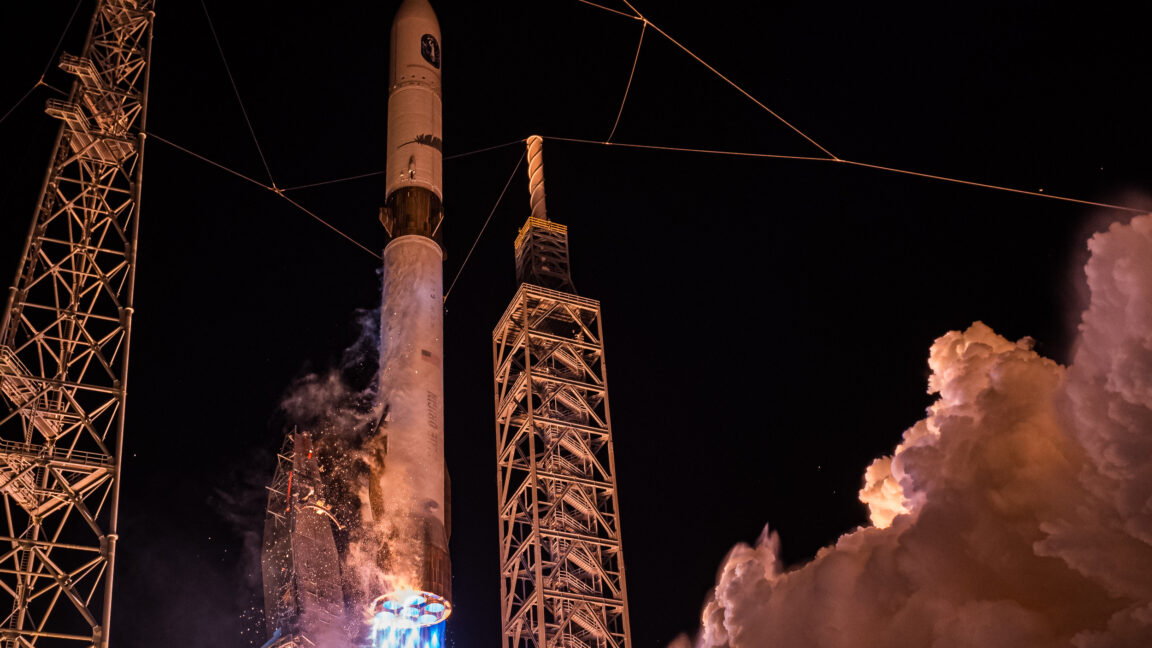Science
Blue Origin Targets Successful New Glenn Launch for Moon Mission

Blue Origin is preparing for the critical second launch of its New Glenn rocket, which plays a pivotal role in a NASA mission aimed at studying Mars’s upper atmosphere. This mission, funded by NASA, involves sending two satellites to the red planet to gather insights into how Mars transformed from a warmer, wetter environment to the cold, arid world it is today.
The success of this launch is essential not only for advancing NASA’s scientific goals but also for Blue Origin’s aspirations to secure certification from the United States Space Force for launching national security satellites. Additionally, the company hopes to reuse the New Glenn rocket’s first stage booster for an upcoming Moon mission. Crews will again deploy Blue Origin’s landing platform into the Atlantic Ocean, replicating the approach taken during the inaugural New Glenn flight in January.
The first launch successfully achieved orbit, a notable accomplishment for any rocket’s debut. However, the booster fell into the Atlantic after three of its engines failed to reignite in time for landing. Following this setback, engineers identified seven modifications to improve performance, focusing on what Blue Origin describes as “propellant management and engine bleed control improvements.”
Focus on Recovery and Reuse
Pat Remias, Blue Origin’s vice president of space systems development, expressed confidence in the upcoming launch during a presentation at the International Astronautical Congress in Sydney. “We fully intend to recover the New Glenn first stage on this next launch,” he stated. The launch is expected to take place no earlier than November from Cape Canaveral Space Force Station in Florida.
The booster stage for this mission has been aptly named “Never Tell Me The Odds,” reflecting the ambitious nature of Blue Origin’s plans. A successful landing is crucial, as the booster from this flight is intended to be reused in the third New Glenn launch, anticipated for January 2024. This third mission will carry the Blue Moon Mark 1 lander, designed to deliver up to **3 metric tons** (approximately **6,600 pounds**) of cargo to the Moon.
“We will use that first stage on the next New Glenn launch,” Remias confirmed, emphasizing the company’s intention to recover and refurbish the booster for rapid reuse. Notably, the timeline for refurbishment is projected to be within **90 days**, which would signify a remarkable achievement in rocket reusability.
Strategic Implications and Future Plans
Dave Limp, Blue Origin’s CEO, acknowledged the challenges ahead, noting that recovering the booster on this upcoming flight will require “a little bit of luck and a lot of excellent execution.” The production of the New Glenn rocket’s second stages has significantly outpaced that of the booster stages. The second stage for the upcoming flight underwent a test-fire in April, while preparations for the third second stage are progressing.
Currently, the assembly of the second New Glenn booster is underway, with the installation of its seven BE-4 engines making substantial progress at the company’s facility in Florida. The limited production of the GS1 boosters is a deliberate strategy aimed at ensuring each unit is more robust and capable of quick recovery and reuse.
Despite the challenges, there is optimism for Blue Origin’s future. Laura Maginnis, vice president of New Glenn mission management, reported that the company is building a fleet of “several boosters” and has eight upper stages in storage, which positions them well for an increased launch cadence in 2024.
If the next launch concludes with a successful booster recovery, it will not only enhance Blue Origin’s capabilities but also accelerate the development of its lunar ambitions. The Blue Moon Mark 1 lander will be fully assembled and is slated to undergo testing at NASA’s Johnson Space Center in Houston before making its way to Florida for launch preparations.
The stakes are high for Blue Origin as it aims to join NASA’s efforts to return humans to the Moon. With **China** actively pursuing its lunar program and aiming for a crew landing by **2030**, the urgency for the United States to achieve a successful Moon mission has intensified.
In conclusion, the upcoming New Glenn launch is more than just a mission; it represents a critical juncture for Blue Origin’s future in space exploration. A successful outcome could pave the way for further advancements in lunar exploration and solidify the company’s position in the competitive landscape of aerospace.
-

 Science3 months ago
Science3 months agoToyoake City Proposes Daily Two-Hour Smartphone Use Limit
-

 Top Stories3 months ago
Top Stories3 months agoPedestrian Fatally Injured in Esquimalt Collision on August 14
-

 Health3 months ago
Health3 months agoB.C. Review Reveals Urgent Need for Rare-Disease Drug Reforms
-

 Technology3 months ago
Technology3 months agoDark Adventure Game “Bye Sweet Carole” Set for October Release
-

 World3 months ago
World3 months agoJimmy Lai’s Defense Challenges Charges Under National Security Law
-

 Lifestyle3 months ago
Lifestyle3 months agoVictoria’s Pop-Up Shop Shines Light on B.C.’s Wolf Cull
-

 Technology3 months ago
Technology3 months agoKonami Revives Iconic Metal Gear Solid Delta Ahead of Release
-

 Technology3 months ago
Technology3 months agoApple Expands Self-Service Repair Program to Canada
-

 Technology3 months ago
Technology3 months agoSnapmaker U1 Color 3D Printer Redefines Speed and Sustainability
-

 Technology3 months ago
Technology3 months agoAION Folding Knife: Redefining EDC Design with Premium Materials
-

 Business3 months ago
Business3 months agoGordon Murray Automotive Unveils S1 LM and Le Mans GTR at Monterey
-

 Technology3 months ago
Technology3 months agoSolve Today’s Wordle Challenge: Hints and Answer for August 19









